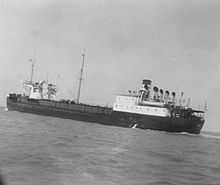Lake tanker

Lake tankers were small (up to 5,000 ton) specially designed tanker ships that carried the crude oil, pumped from beneath Lake Maracaibo in Venezuela, to the three off-shore refineries located on the Dutch islands of Aruba and Curaçao.
Background
The crude obtained from Lake Maracaibo was processed at refineries located at Aruba and Curaçao, Netherlands West Indies. Aruba had two refineries, Lago Oil and Transport Company, owned by Standard Oil of New Jersey and Eagle, owned by Royal Dutch Shell. There was also a Royal Dutch Shell refinery on the island of Curaçao. The Lago refinery housed the officers and their families in Lago Colony, a community owned by the company which housed all their foreign staff employees.
All three refineries depended on a fleet of "Lake Tankers" to supply the crude to be refined, carried from Lake Maracaibo through the shallow cannel between it and the Caribbean Sea. This shallow passage prevented larger oceanic tanker ships from entering the lake, and thus the need for the smaller Lake tanker.
Description
The Lake Tanker was a small vessel in comparison with the larger ocean-going oil tankers; they had a very shallow draft with a flat bottom, which allowed the ship to maneuver over the ever shifting sand bars that blocked the channel going into Lake Maracaibo.
History
The first Lake Tankers (SS Invercorrie, SS Inverampton, and SS Francunion) were built in England around 1923, entering service in 1924.[1] Subsequent ships remained small until after World War II when, with the dredging of the channel to Lake Maracaibo, the lake tankers became larger.
This collection of small tankers was known as the "Lake fleet", which peaked at more than 60 ships, either owned or chartered.[1] This type of tanker was no longer needed after the channel from Lake Maracaibo to the sea was finally dredged and deepened to allow ocean-going tankers to enter the lake, and pipelines from the lake were constructed to deep water ports in the Paraguana Peninsula.
The last Lake Tanker, SS Trujillo, was retired from service in December 1954 and sailed to Jacksonville, Florida, where it joined another 12 decommissioned Lake tankers that had been active as of January 1954.[1]
Lake fleet
Some tankers that have been part of the "Lake fleet" are listed below.
Lago Oil fleet
- SS Oranjestad[2]
- SS Ambrosio[3]
- SS Bachaquero[3]
- SS Invercaibo[3]
- SS Hooiberg[3]
- SS Invergoil[3]
- SS Punta Gorda[3]
- SS San Carlos[3]
- SS Tia Juana[3][4]
- SS Yamanota[3]
- SS Pedernales[1]
- SS Andino[1]
- SS Quiriquire[1]
- SS Misoa[1]
- SS Cumarebo[1]
- SS Maracay[1]
- SS Boscan[1]
- SS Caripito[1]
- SS Guarico[1]
- SS Temblador[1]
- SS Amacuro[1]
- SS Mara[1]
- SS Trujillo[1]
Shell Oil fleet
- SS Adela[5]
- SS Alicia[5]
- SS Asiento[5]
- SS Berta[5]
- SS Brigida[5]
- SS Carlota[5]
- SS Casandra[5]
- SS Chepita[5]
- SS Conchita[5]
- SS Dolium[5]
- SS Elena[5]
- SS Felipa[5]
- SS Frasca[5]
- SS Gadinia[5]
- SS Galeomma[5]
- SS Ganesella[5]
- SS Gari[5]
- SS Gastrana[5]
- SS Gaza[5]
- SS Gemma[5]
- SS Gena[5]
- SS Genota[5]
- SS Geomitra[5]
- SS Glebula[5]
- SS Glessula[5]
- SS Gomphina[5]
- SS Gouldia[5]
- SS Gyrotoma[5]
- SS Josefina[5]
- SS Juanita[5]
- SS Juliana[5]
- SS Julieta[5]
- SS Justina[5]
- SS Laura[5]
- SS Leona[5]
- SS Leonor[5]
- SS Leticia[5]
- SS Lidia[5]
- SS Linda[5]
- SS Liria[5]
- SS Liseta[5]
- SS Lucia[5]
- SS Lucita[5]
- SS Lucrecia[5]
- SS Luisa[5]
- SS Manuela[5]
- SS Mariana[5]
- SS Mariquita[5]
- SS Marsella[5]
- SS Martica[5]
- SS Martina[5]
- SS Maruja[5]
- SS Matilde[5]
- SS Maximina[5]
- SS Rafaela[5]
- SS Ramona[5]
- SS Rebeca[5]
- SS Renata[5]
- SS Rita[5]
- SS Rodas[5]
- SS Rosa[5]
- SS Rosalia[5]
- SS Rosaura[5]
- SS Rufina[5]
- Shell Aramare[5]
- Shell Caricuao[5]
- Shell Charaima[5]
- Shell Dezoito[5]
- Shell Manaure[5]
- Shell Mara[5]
- Shell Murachi[5]
- Shell Naiguata[5]
- Shell Plata[5]
- SS Shellphalte[5]
- SS Shellspra[5]
- SS Spramex[5]
- SS Susana[5]
British American Oil fleet
(see British-American Oil)
References
Notes
- ↑ 1.0 1.1 1.2 1.3 1.4 1.5 1.6 1.7 1.8 1.9 1.10 1.11 1.12 1.13 1.14 1.15 1.16 1.17 1.18 "Trujillo Ends Lake Fleet Era". Aruba ESSO News. December 18, 1954. Retrieved 2014-04-19.
- ↑ "Ships hit by U-boats - Oranjestad". Uboat.net. Retrieved 2014-09-03.
- ↑ 3.0 3.1 3.2 3.3 3.4 3.5 3.6 3.7 3.8 "LAKE TANKER PHOTOS". LAGO COLONY & LAGO REFINERY, ARUBA. Dan Jensen. Retrieved 2014-04-24.
- ↑ "Ships hit by U-boats - Tia Juana". Uboat.net. Retrieved 2014-09-07.
- ↑ 5.0 5.1 5.2 5.3 5.4 5.5 5.6 5.7 5.8 5.9 5.10 5.11 5.12 5.13 5.14 5.15 5.16 5.17 5.18 5.19 5.20 5.21 5.22 5.23 5.24 5.25 5.26 5.27 5.28 5.29 5.30 5.31 5.32 5.33 5.34 5.35 5.36 5.37 5.38 5.39 5.40 5.41 5.42 5.43 5.44 5.45 5.46 5.47 5.48 5.49 5.50 5.51 5.52 5.53 5.54 5.55 5.56 5.57 5.58 5.59 5.60 5.61 5.62 5.63 5.64 5.65 5.66 5.67 5.68 5.69 5.70 5.71 5.72 5.73 5.74 5.75 5.76 Kees Helder and others. "Tankers in class Lake Maracaibo Tankers". Helder Line – Shell tankers. Kees Helder. Retrieved 2015-02-22.
- ↑ 6.0 6.1 Doug Hand. "History of the British American Oil Company, page 10". British American Oil Throughout the Years. Alex Colwell. Retrieved 2015-02-14.
External links
- A story about Lago's Lake Tankers
- History of Lago Oil Shipping Co., Ltd.
- Lago Colony & Lago Refinery with links to Lake Tanker photos
- Helder Line website, List of Shell Lake Tankers (accessed 2015-02-15)
- Auke Visser's website, A story about Lago Oil tankers (accessed 2015-02-15)
- Auke Visser's website, Lago / Creole Petroleum Corp., list of all their ships with link to individual stories (accessed 2015-02-21)
- The Ships List website, Andrew Weir & Co. / Bank Line (accessed 2015-02-16)
- Harland and Wolff shipyard website, ship search page (accessed 2015-02-17)